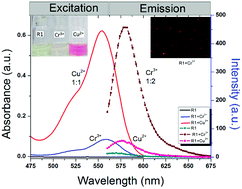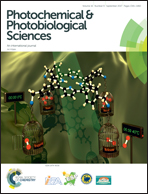A triple action chemosensor for Cu2+ by chromogenic, Cr3+ by fluorogenic and CN− by relay recognition methods with bio-imaging of HeLa cells†
Abstract
A triple action chemosensor (R1) bearing a rhodamine and thiophene moiety was synthesized by a simple condensation reaction. The sensing behaviour and selectivity of the synthesized chemosensor toward metal ions were studied by UV-Vis and fluorescence spectroscopy. The chemosensor recognized Cu2+ and Cr3+ ions with significant changes in UV-Vis absorbance and fluorescence intensity. The results showed that Cr3+ induced greater fluorescence enhancement whereas Cu2+ ions bound strongly with the receptor by showing a strong absorption band at 554 nm but with weak fluorescence. A visible colour change was observed by the addition of Cu2+ and that colour change is due to the opening of the spirolactam ring triggered by the addition of Cu2+ ions. Job's plot analysis indicated a 1 : 2 and 1 : 1 binding stoichiometry between the chemosensor and Cr3+/Cu2+. Subsequently, the R1 − Cu2+ complex chemosensor was employed to detect CN− in the presence of different anions, such as F−, Cl−, Br−, I−, AcO−, H2PO4−, HSO4−, NO3− and −OH. In addition, the live cell imaging of HeLa cells using R1 and Cr3+ was demonstrated successfully.



 Please wait while we load your content...
Please wait while we load your content...